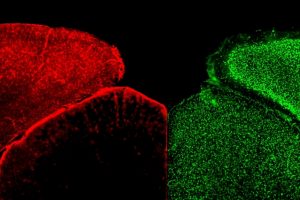
Image of a dendrite with spines expressing a red fluorescent protein together with a green tag for the protein Arc, obtained with two-photon microscopy in an awake mouse. Image courtesy of PILM/Sur Lab
[Source: Picower Institute for Learning and Memory, June 22, 2018]
Our brains are famously flexible, or “plastic,” because neurons can do new things by forging new or stronger connections with other neurons. But if some connections strengthen, neuroscientists have reasoned, neurons must compensate lest they become overwhelmed with input. In a new study in Science, researchers at the Picower Institute for Learning and Memory at MIT demonstrate for the first time how this balance is struck: when one connection, called a synapse, strengthens, immediately neighboring synapses weaken based on the action of a crucial protein called Arc.
Senior author Mriganka Sur said he was excited but not surprised that his team discovered a simple, fundamental rule at the core of such a complex system as the brain, where 100 billion neurons each have thousands of ever-changing synapses. He likens it to how a massive school of fish can suddenly change direction, en masse, so long as the lead fish turns and every other fish obeys the simple rule of following the fish right in front of it.
“Collective behaviors of complex systems always have simple rules,” said Sur, Paul E. and Lilah Newton Professor of Neuroscience in the Picower Institute and the department of Brain and Cognitive Sciences at MIT. “When one synapse goes up, within 50 micrometers there is a decrease in the strength of other synapses using a well-defined molecular mechanism.”
This finding, he said, provides an explanation of how synaptic strengthening and weakening combine in neurons to produce plasticity.
